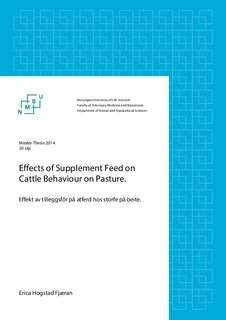Effects of supplement feed on cattle behaviour on pasture
Master thesis
Permanent lenke
http://hdl.handle.net/11250/274941Utgivelsesdato
2015-01-28Metadata
Vis full innførselSamlinger
- Master's theses (IHA) [318]
Sammendrag
Genetics, supplement feed, environment, and management affect cattle behaviours and diurnal
patterns on pasture, thus reflecting individual and/or group difference in time budgets. The
aim of this study was to investigate effects of supplement feed on grazing behaviour and
distance travelled by Zebu heifers during mid-rainy season in Tanzania. 18 heifers aged 3-5
years were assigned to one of three treatments: pasture only (PO), pasture plus supplement
(PS), and supplement only (SO). Supplements were distributed twice daily before and after
pasture, and consisted of ad lib access to untreated straw plus concentrate (5 kg / heifer / day)
for the PS group, and ad lib access to treated straw plus concentrate (5 kg / heifer / day) for
the SO group. The restricted pasture management of 8 hours daily grazing time (0900-1700)
included the PO and PS groups only. For 11 consecutive days on pasture, behavioural
observations, distance travelled, weather type, and temperature was recorded during two daily
observation bouts from 0900-1200, and 1400-1700. Behavioural observations included scan
intervals every 10 min, registering location on pasture according to a grid map, and activity
within one of six behaviours: (1) grazing, (2) walking without grazing, (3) ruminating while
standing, (4) ruminating while lying, (5) resting, and (6) other. Additionally, six days of
behavioural observations during supplement feeding times were conducted. Mean initial
bodyweights (BW) prior to trial was 229 ± 39 kg for all animals, and after one month on trial
mean BW gains were 13.2 ± 4.2 kg, 31.3 ± 6.8 kg, and 23.2 ± 7.4 kg, for the PO, PS, and SO
groups, respectively.
As predicted, providing heifers with supplement feed decreased time spent grazing (in % of
total time) during morning (PO=88.4 ± 2.1, PS=78.5 ± 2.9, P ≤ 0.05) and afternoon (PO=72.1
± 4.8, PS=60.3 ± 4.8, P=0.10) observation bouts. Thus, morning activity created significant
differences in resting (PO=2.9 ± 1.3, PS=7.5 ± 1.7, P ≤ 0.05) and other behaviours (PO=2.2 ±
0.6, PS=5.4 ± 0.7, P ≤ 0.01). During the afternoon, a further decline in time spent grazing
successively increased time spent resting (PO=7.7 ± 2.6, PS=11.5 ± 1.8, P=0.25) and other
behaviours (PO=2.9 ± 0.5, PS=6.6 ± 1.2, P ≤ 0.05). Ruminating while standing had the largest
increase in percent of time from morning (PO=1.0 ± 0.6, PS=1.8 ± 0.6, P=0.40) to afternoon
(PO=7.2 ± 2.5, PS=10.9 ± 2.9, P=0.34).
Distances travelled remained equal between PO and PS groups on pasture, with slightly
longer distances travelled during morning (PO=692.9 ± 64.6 m, PS=643.3 ± 50.3 m, P=0.55)
v
than afternoon (PO=600.4 ± 68.5 m, PS=595.5 ± 63.7 m, P=0.96) bouts. When blocked by
weather categories, the PO group (1575.0 m) walked significantly farther than the PS group
(1362.5 m) during overcast weather (P ≤ 0.05). In addition, the PS group consistently spent
less time grazing than the PO group, and differences were significant in three of four weather
categories (mixed overcast: P=0.18, overcast: P ≤ 0.0001, mixed sunny: P ≤ 0.0001, and
sunny: P ≤ 0.05).
During supplement feeding, there were significant individual differences in time spent eating
concentrate (P ≤ 0.01), walking/relocating (P ≤ 0.05), and eating straw (P ≤ 0.05) within the
PS group, yet no individual differences were found in time spent grazing on pasture (P=0.54).
